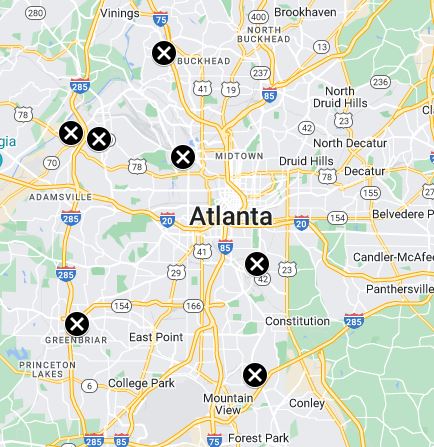Be the first to know about what’s impacting your Atlanta neighborhood!
Click HERE to sign up here for a daily email to know about tree removal, new construction, new businesses opening, and more activity affecting your neighborhood.
Text TREES to 404-637-0080 to get regular text messages about new arborist activity within a ½ mile of your house.
Properties with Most Trees Removed
Click on the map below to see an interactive map of where the greatest number of healthy trees were permitted for removal between January 1 and June 30, 2022. Each 'X' marks where more than 200 trees were permitted. Click on each 'X' for permit detail.
Note: Healthy tree loss stopped being reported by the Arborist Division after June 30, 2022.
Atlanta Tree Loss More Than Doubled!
We are now LOSING OVER TWICE AS MANY HEALTHY TREES each year compared to four years ago, according to the City of Atlanta tree data. Tree loss significantly increased in all removal categories over the past four years, with a huge upsurge in healthy tree removals, both permitted and illegally removed, starting in 2021:
- Healthy tree removal has increased by 121% since 2020.
- Illegal tree removal has nearly doubled in the past four years, but it's more than doubled when the unknown number of trees cleared on 33 acres in 2023 are included.
- The removal of dead, dying, and hazardous (DDH) trees has not grown as much, but is still 7% more than 2020 (which is 21% more than the previous year, FY2019).
(Click on image below to enlarge.)
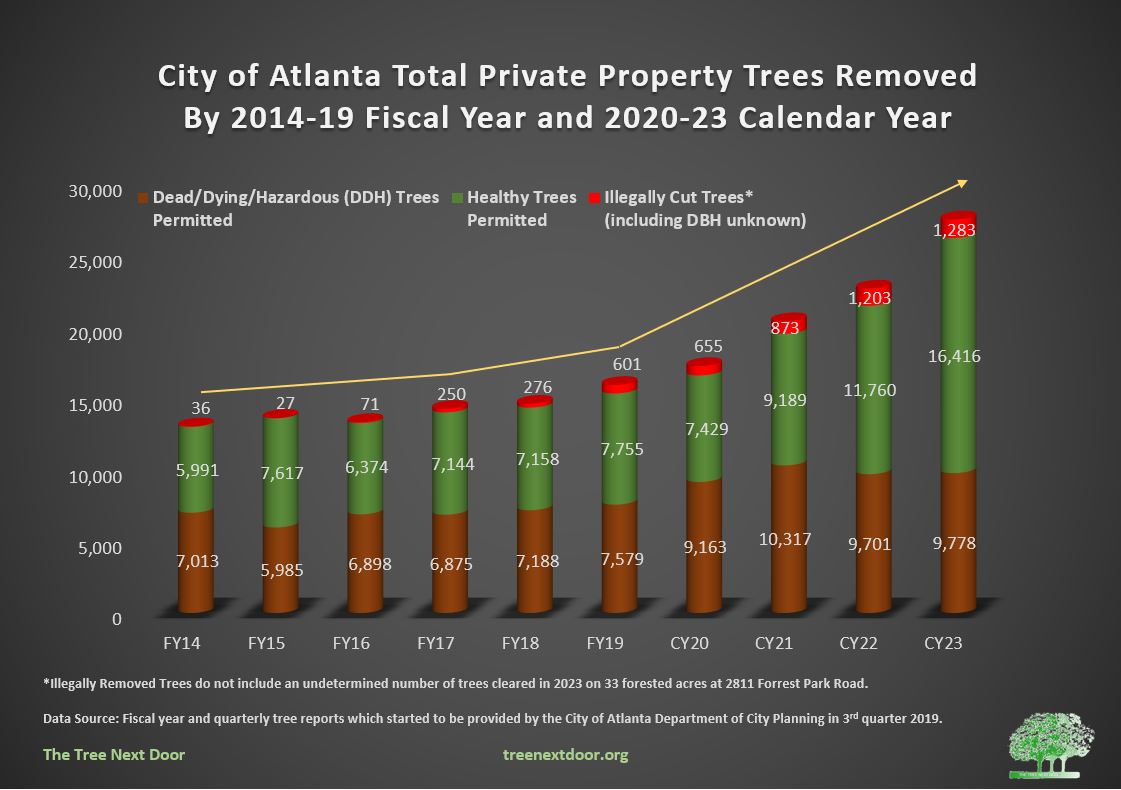
Chart note: Before 2020, tree loss data was provided only by fiscal year (FY), from July 1 to June 30.
2022 Changes to Tree Ordinance Had No Impact on Tree Loss
The changes made to strengthen the Tree Ordinance and give the city arborists more flexibility to save trees did nothing to reduce tree loss. Instead, TREE LOSS SURGED. When comparing the last three quarters of 2023 (after the new Tree Ordinance was implemented) to the same period in 2022:
- Healthy tree removals increased by 44%.
- Illegal tree removals grew by 42%, although the growth in illegal tree removal is understated because the number of trees cleared illegally on 33 acres at 2811 Forrest Park Road is unknown and not included.
- Dead, dying, and hazardous tree removals rose slightly by 4%.
(Click on image below to enlarge.)
We don't know if these tree loss trends continued in the first quarter of 2024 because the City stopped publishing tree loss data at the end of 2023. City Planning Commissioner Jahnee Prince has instructed the Arborist Division to wait until the City's new interactive dashboard is ready before any more tree data is released to the public. This withholding of quarterly data means the City is not in compliance with Sec. 158-103(f) of the Tree Protection Ordinance.
Please click on each tree category below to understand more about the tree loss in each category.
Key takeaways:
- Healthy tree removal has increased by 121% over the past three years. Prior to 2021, there was no growth trend in the number of healthy trees removed.
- Our Tree Ordinance currently focuses on preserving trees on lots zoned as single-family residential, but the majority of our tree canopy loss is now happening on multi-family and commercial developments.
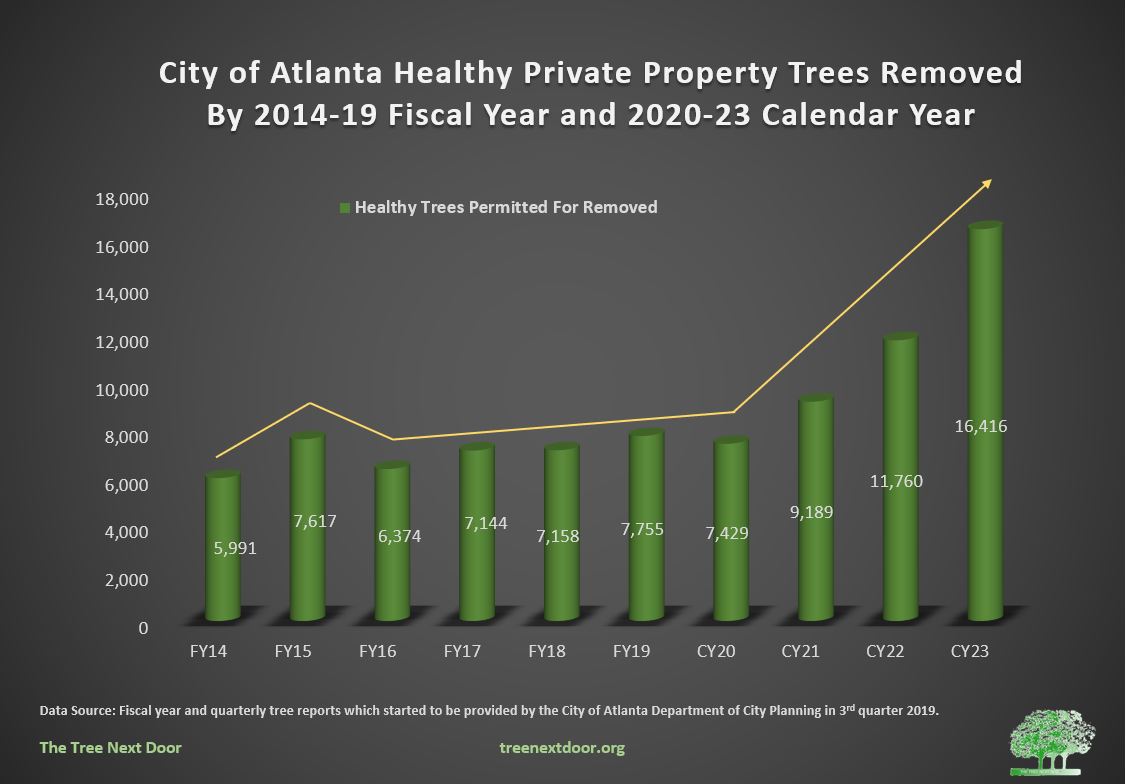
Chart note: Before 2020, tree loss data was provided only by fiscal year (FY), from July 1 to June 30.
Dead, Dying and Hazardous (DDH) Trees
Key takeaways:
- DDH tree removals are not growing as fast as other categories of tree removal, but are still 7% more than 2020 and 40% more than the average number removed before 2020.
- Very few DDH permit applications are denied and the DDH approval rate in 2023 is back up to the all-time high approval rate we saw in 2020, when the city arborists were not conducting onsite inspections due to Covid. During the six years prior to Covid, approval rates were around 81%. Since Covid, approval rates have been consistently higher, between 89% to 94%. This pattern of approving almost all trees submitted as DDH is concerning given there is no right to appeal a DDH decision.
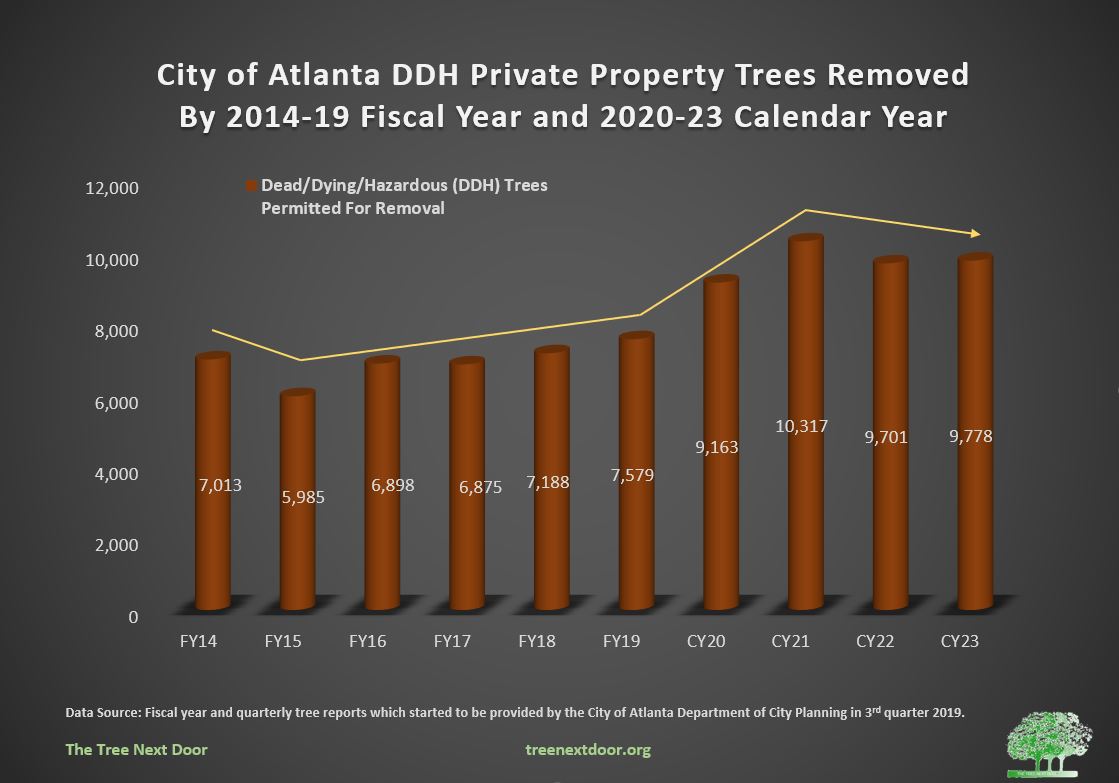
Chart note: Before 2020, tree loss data was provided only by fiscal year (FY), from July 1 to June 30.
Key takeaways:
- Illegal tree removal has more than doubled since 2020, allowing for an unknown number of trees removed from 33 acres in 2023.
- Current fines with no court citations have been ineffective in curbing illegal tree removal.
- The Atlanta Police Department no longer stops illegal tree removal as it is happening and there is no other City agency able to fill the gap.
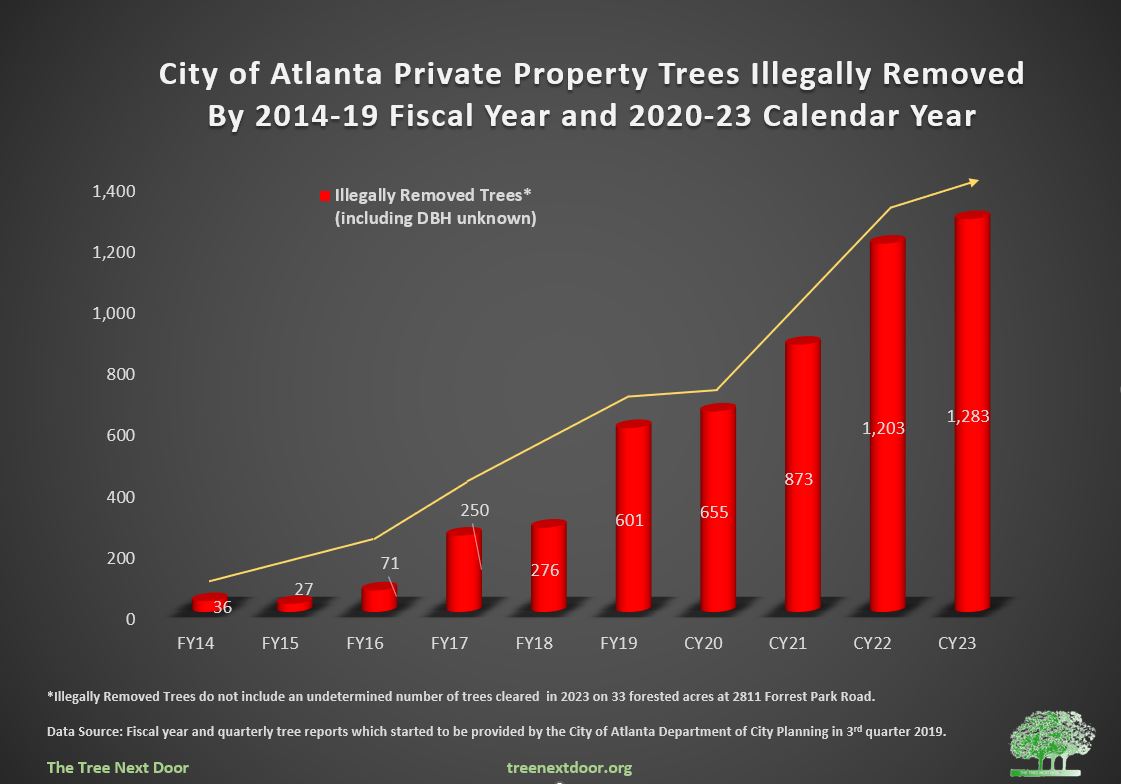
Chart note: Before 2020, tree loss data was provided only by fiscal year (FY), from July 1 to June 30.
Why City Council Isn't Serious About 50% Canopy Goal
Phase 2 of the Tree Ordinance rewrite is currently underway with no commitment to achieving the 50% canopy goal Atlanta City Council established in April 2023. Instead, the official "directive" given by the City to the Tree Ordinance Rewrite committee is to:
• Promote the preservation and management of trees in Atlanta,
• Identify and specify opportunities for efficiently and equitably increasing canopy appropriately located throughout the city,
• While minimizing impacts to developers, home and property owners, the public sector and other stakeholders.
Why Phase 2 of the Tree Ordinance Rewrite Won't Save The Tree Canopy
The directive given to the Phase 2 Tree Ordinance Rewrite committee is purely aspirational, with no actual measurable goals. For the 50% canopy resolution to be effective, City Council must commit to establishing measurable goals, not just continue "promoting" tree preservation. As we saw in the first phase of the Tree Ordinance, giving the arborists more flexibility to save trees wasn't enough to save trees. Now, City Council need to get serious about preserving our existing tree canopy by:
- Insisting on better standards for tree preservation in the Tree Ordinance,
- Limiting the amount of land that can be disturbed in site development, which will require a change to the Zoning regulations currently being rewritten, and
- Raising recompense fees to the current rate it costs to replace removed trees inch-for-inch. Presently, the mandated recompense fees do not begin to cover the actual costs of tree replanting.
None of these commitments are included in the current directive, whereas the commitment to "minimize impact to developers" is. At some point, City Council must realize that an effective Tree Ordinance will impact developers' profits, and there is no "minimum" profit loss the development community will accept as long as City Council lets them keep avoiding it.
Also, changes being presently discussed in our Zoning Ordinance rewrite, which is occurring at the same time as the Tree Ordinance rewrite, do not include rezoning for greater tree preservation and planting. When asked how the new Zoning Ordinance will help save the tree canopy, the response is: "The Tree Ordinance rewrite will address this issue." However, zoning ordinances are integral to preserving land for trees, and yet the Zoning and Tree Ordinance rewrites are occurring in silos.
If we don't change the Zoning Ordinance to limit land disturbance on construction sites, the Tree Ordinance is powerless to save most all the trees currently being destroyed by development!
